In the rich tapestry of ancient Egyptian mythology and ritual practices, few symbols carry as profound a cosmic significance as the Ladder, a motif explored with intriguing depth in Wallis Budge’s seminal work, “Egyptian Magic.”
The section titled “The Amulet of the Ladder” presents a captivating snapshot of how the ancients envisioned the passage from mortal existence to the divine realm, encapsulating a blend of myth, magic, and the material culture of funerary customs.
Budge’s work stands as a testament to the enduring enigma of Egyptian eschatology, laying bare the Egyptians’ fixation with the afterlife—a realm ruled by deities and accessible only through mystical ascent.
The ladder, an object so mundanely physical, is transformed into a potent talisman, encapsulating the Egyptians’ fervent desire to traverse the celestial expanse.
The excerpt opens by setting the cosmic stage—an iron plate serving as the heavenly floor, resting on pillars aligning with the cardinal points.
It’s a worldbuilding detail that illustrates the Egyptians’ efforts to marry the abstract with the concrete, a heaven both a physical place and a metaphysical state.
The proximity of this divine plane to earthly mounts provided the backdrop for the ladder’s functional necessity and symbolical potency.
At the heart of the narrative is the story of Osiris, the god whose own struggles and eventual ascension to the heavenly iron plate set the precedent for mortal aspirations.
The ladder thus emerges as not just a tool but a divine gift, a means of climbing not only towards the stars but towards one’s own deification, echoing the Osirian mythos.
It’s a portrayal ripe with the theme of divine assistance, wherein the ladder becomes a bridge between humanity and gods, between the earthly and the heavenly.
Budge presents the ladder as a dual symbol—both a literal object placed within tombs and a metaphorical path to the afterlife.
The amulets found by archaeologists, according to Budge, served as magical aids to ensure the deceased’s passage. This dualism mirrors the Egyptians’ worldview, which saw magic and material as intrinsically intertwined.

The Amulet of the Ladder
IMAGE: the square magazine digital collection
The magic, as detailed in the spells and incantations, is rooted in a dialogue with the divine. The dead, speaking through these texts, don’t passively enter the afterlife but actively engage with the mechanisms of their ascent.
The ladder is thus not merely climbed but conjured, animated by words that breathe life into wood or stone, transforming them into cosmic elevators.
Pepi’s address to the ladder is particularly poignant, illustrating the personalization of the ritual. By identifying with Horus, the individual dead became, in essence, divine, echoing the Osirian narrative of rebirth and victory over death.
The deceased, in these rituals, become participants in the divine drama, actors taking up roles that have been played out in myth for generations.
Yet, there’s an inherent tension within the text, oscillating between the magical and the mundane. The ladder, a simple structure by which one climbs to higher places in the physical world, in the hands of Budge, becomes a conduit for complex spiritual concepts.
This dichotomy lies at the heart of much of Egyptian religious thought, as seen in their gods who walked the line between the comprehensible and the incomprehensible.
Budge’s discussion extends beyond the ladder itself to the societal implications of such beliefs. The deceased’s expected release from earthly toils reflects the desire to escape the mundane burdens of life.
The ladder leads to a place where the needs of the body are supplanted by the sustenance of the soul, a theme that resonates with universal human yearnings.
The review cannot ignore the historical and cultural context in which Budge’s work was written. His interpretations, while insightful, were produced during a time when Egyptology was still in its infancy, and later scholarship has both built upon and contested his conclusions.
It’s crucial to approach “Egyptian Magic” with a critical eye, recognizing both its contributions to the field and the limitations of its time.
In conclusion, “The Amulet of the Ladder” section in “Egyptian Magic” is a compelling exploration of ancient Egyptian beliefs about the afterlife and the magical practices associated with it.
While succinct, it encapsulates the grandeur and complexity of Egyptian religious thought and provides a window into the interplay between the physical and the spiritual in the pursuit of immortality. Budge’s work remains a cornerstone in the study of Egyptian magic and religion

The Amulet of the Ladder
IMAGE: the square magazine digital collection
The lesson on the Amulet of the Ladder, while primarily a historical and mythological account, also offers abstract lessons in personal development and leadership. Here are some insights drawn from the excerpt:
– Aspiration and Vision: The ancient Egyptians’ belief in an afterlife on a divine iron plate represents the importance of having a vision or a higher goal to aspire to, a crucial element for personal development and leadership.
– Overcoming Obstacles: The notion that Osiris needed a ladder to ascend to heaven reflects the idea that obstacles are inherent in any journey, whether personal or professional. Overcoming these requires resourcefulness, akin to finding or creating a “ladder” to reach one’s objectives.
– Support Systems: The gods Râ and Horus helping Osiris ascend the ladder is symbolic of the importance of having support systems and being a support for others. In leadership, this underscores the value of mentorship and teamwork.
– Persistence and Resilience: The fact that a deity like Osiris experienced difficulties in ascending to the iron plate serves as a reminder that challenges are universal. Persistence and resilience are key traits for success.
– Empowerment through Identification: By identifying with Horus, the deceased claimed their place among the gods. This parallels the concept of “assuming the role” in personal development and “acting the part” in leadership, embodying the qualities one aspires to have.
– Ritual and Consistency: The ritualistic placing of ladder models in tombs can be interpreted as the importance of consistent practices and habits in achieving long-term goals, a vital aspect of personal growth and effective leadership.
– Innovation and Adaptation: The Egyptians’ use of magical texts to aid the deceased’s journey reflects innovation. In modern terms, it suggests that developing creative solutions and adapting to new challenges are important for personal and professional growth.
– Communication: The incantations to animate the ladder highlight the power of communication. Articulating one’s needs and vision clearly is crucial in personal development and is a cornerstone of effective leadership.
– Strategic Alliances: Invoking gods like Khonsu and Sept for assistance with the ladder suggests that strategic alliances can be key in achieving objectives, a lesson applicable in leadership and personal endeavors.
– Focus on the End Goal: The text suggests the Egyptians were focused on the ultimate goal of reaching the afterlife in a state of bliss. Similarly, keeping one’s end goals in mind is essential for staying motivated and leading others effectively.
In summary, the excerpt provides metaphors for goal setting, overcoming challenges, the importance of support, the power of identification and role assumption, the need for consistent practice, innovation, clear communication, strategic relationships, and focus on objectives, all of which are valuable in the realms of personal development and leadership.
Article by: Grant Marsed

Grant Marsed was made a mason in a Liberal Grand Lodge which is associated with CLIPSAS.
He is a retired engineer and devotes much of his time to traveling and philosophical writing.
Recent Articles: Masonic Miscellanies
 Masonic Miscellanies - The Amulet of the Ladder Explore the cosmic significance of the Ladder in ancient Egyptian mythology through Wallis Budge's "Egyptian Magic." Discover how this profound symbol bridges the mortal and divine, encapsulating the Egyptians' fervent afterlife aspirations with a blend of myth, magic, and material culture. Dive into the celestial ascent of Osiris and mortal souls. |
 Masonic Miscellanies - Adulterine Gilds Guilds, the associations that shaped medieval European society, were more than just organizations of artisans and merchants. They played a vital role in the economic and social development of towns and cities. This exploration delves into the intriguing concept of adulterine gilds and their interconnectedness with guilds, offering insight into the significance of legal authorization and recognition in medieval Europe. |
 Masonic Miscellanies - Masonic Orb Discover the fascinating world of Masonic ball watch fobs, intricately crafted with tiny pyramids that form a cross when opened. These decorative accessories were all the rage in the late 1800s and early 1900s, and they still hold a certain allure today. Explore the different varieties and symbols found on these unique pieces that carry deep Masonic meaning. |
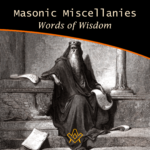 Masonic Miscellanies – Words of Wisdom Uncover timeless wisdom from King Solomon to Albert Pike in our latest Masonic Miscellanies, a treasure trove of insights for Masons. Journey through the ages and glean inspiring sayings, reflecting on their profound influence on Masonic principles. An enriching read for the enlightened. |
 Masonic Miscellanies - Symbolism of the Right Hand Unlock the enigmatic realm of Freemasonry as we delve into its age-old symbols, rituals, and philosophies. This thought-provoking exploration, drawn from Mackey's Revised Encyclopedia of Freemasonry, focuses on the iconic 'right hand' symbol - its rich history, universality, and profound significance. |
 Masonic Miscellanies - Order of the Secret Monitor Unveil the mystery of Freemasonry with 'The Order of the Secret Monitor'. Discover this lesser-known appendant order, its unique rituals, and the profound teachings it offers. Explore the bonds of friendship and brotherhood it fosters, all wrapped in an intriguing cloak of mystery. Your journey into the depths of Masonic wisdom begins here. |
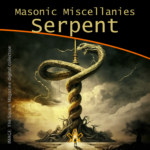 Masonic Miscellanies - The Symbol of the Serpent As a symbol, the serpent obtained a prominent place in all the ancient initiations and religions. |
 Masonic Miscellanies - The Four Veils in Royal Arch Masonry What are the four veils in Royal Arch Masonry? And what is the 'Ceremony of Passing the Veils'? Although common throughout Scotland, Ireland and the United States, it is mostly unknown in England, presently only worked in the Province of Bristol. ( and by dispensation ) |
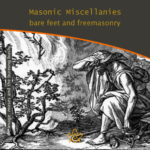 Masonic Miscellanies - Bare feet and Freemasonry A candidate for initiation into a Masonic Lodge often finds the requirements which he/she must fulfil somewhat odd. The mode of preparation often remains a puzzle, since the ritualistic explanation is not offered in full. Why are we 'slipshod' or "bare-footed" in Masonic Ritual? |
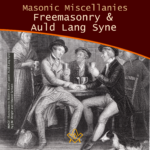 Masonic Miscellanies – Freemasonry and Auld Lang Syne Millions of people throughout the world will sing Auld Lang Syne to see out the Old Year. Few will know all the words, fewer still know what they mean, or that there is a link to Freemasonry. |
 Masonic Miscellanies - The Mosaic Pavement - why mosaic, why pavement? We are all familiar with the black and white chequered flooring of the Masonic lodge but where did it originate? There are a few theories… |
 Masonic Miscellanies – Masonic Master's Carpets Have you got a magic "Masonic Master's Carpet" in your lodge? I say 'magic' with my tongue firmly in my cheek because (as far as I know) these fabulous works of art don't bestow any mystical powers but can bestow some educational ones! However, considering their possible value today, they may magic up some interest (or funds). |
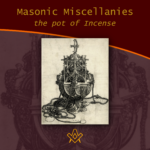 Masonic Miscellanies – The Pot of Incense Just when the pot of incense became an emblem of the third section of the Sublime Degree can not be stated with certainty. It is, apparently, an American invention or addition. But what does it symbolise? |
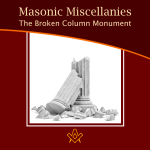 Masonic Miscellanies - The Broken Column Monument The story of the broken column was first illustrated by Amos Doolittle in the "True Masonic Chart" by Jeremy Cross, published in 1819. |
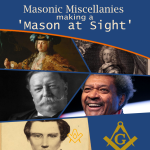 Masonic Miscellanies - Making a 'Mason at Sight' What does it mean to make a 'Mason at sight', and who was made one? |
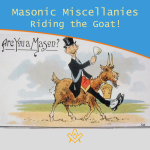 Masonic Miscellanies - Riding the Goat! Many Freemasons will have come across the phrase 'riding the goat', and will no doubt have been the butt of a joke about it (sorry, I couldn't resist!) But what does it mean and where did the phrase come from? |
 Masonic Miscellanies - What are the 'three dots'? Three dots or points in an upright triangular shape ∴ is most commonly known as the 'therefore' sign – so why is it used in Freemasonry? |
 Masonic Miscellanies - Keep Within Compass This month we discover a series of allegorical prints warning us to "Keep within Compass and you shall be sure, to avoid many troubles which others endure." |
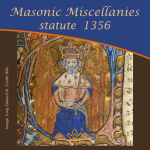 Masonic Miscellanies - statute 1356 Further to the reference in the article – The Builders - 6 - Free-Masons 'a statute was enacted against the Free-masons in 1356' – Regulations for masons who are hewers, on the one hand, and the light masons and setters on the other. |
 Masonic Miscellanies - An Anti-Masonic 'Apron'? The Anti-Masonic 'Apron' was created during the 1832 Presidential election in USA. It was not Ani-masonic. And it was not an apron. Read on to find out what and why it was created. |
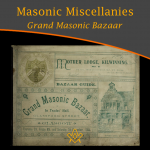 Masonic Miscellanies - Grand Masonic Bazaar (1895) Grand Masonic Bazaar (1895); to raise funds to clear the debt incurred by “Mother Kilwinning” in rebuilding their Lodge. |
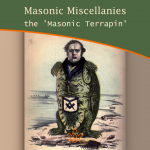 Masonic Miscellanies - the 'Masonic Terrapin' A satirical book from 1851 includes a bizarre caricature of a 'Masonic Terrapin' - all I can say is 'read on'… |
 Masonic Miscellanies - Masonic Bookplates You probably know what a bookplate is for, but did you know that the earliest known book mark/label dates from the reign of Amenhotep III in Egypt around 1391−1353 BCE?! |
 Masonic Miscellanies - Freemasonry & Bees Freemasonry & Bees - what's the buzz? The bee was among the Egyptians the symbol of an obedient people, because, says Horapollo, of all insects, the bee alone had a king. |
 Masonic Miscellanies - The mystery of the Tattooed Freemason In 1894, the body of a drowned man was found in the Bay of San Francisco - what they discovered was amazing. |
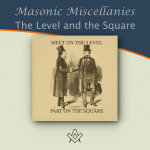 Masonic Miscellanies - The Level and the Square (A Poem) The Level and the Square (A Poem) - "We meet upon the Level, and we part upon the Square – |
 Masonic Miscellanies - The Mystic Tie What is the 'Mystic Tie'? Clue: it's not an item of neckwear! |
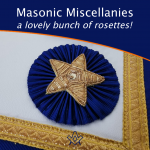 Masonic Miscellanies - A lovely bunch of rosettes! Where did the origin of the use of rosettes on Masonic aprons come from ? |
 Masonic Miscellanies - The Lodge of Sorrow The Lodge of Sorrow - Extracted General Ahiman Rezon, by Daniel Sickles, [1868] |
 Masonic Miscellanies - Memento Mori Memento Mori - a Masonic reminder to make your mark on the world |
 Masonic Miscellanies - A closer look at the Level and the Plumb-rule A closer look at the Level and the Plumb-rule |
 Masonic Miscellanies - The Symbolism of the Gloves The Symbolism of the Gloves and why Freemasons wear white gloves |
 Masonic Miscellanies - Will the real James Anderson please stand up? Will the real James Anderson please stand up? |
 Masonic Miscellanies - The Legend of the Third Degree The most important and significant of the legendary symbols of Freemasonry is, undoubtedly, that which relates to the fate of Hiram Abif. |
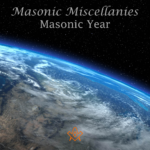 Masonic Miscellanies - Masonic Calendar Why do Freemasons use different 'years' to our regular calendar? |
 Masonic Miscellanies - What is a 'Lewis'? The English word 'Lewis' is a term belonging to operative Masonry, and signifies an iron cramp, which is inserted in a cavity prepared for the purpose in a large stone. |
 Masonic Miscellanies - From J.S.M. Ward Ever wondered why masons had to be 'free' or why we have a Tyler? |
masonic knowledge
to be a better citizen of the world
share the square with two brothers

click image to open email app on mobile device






